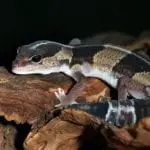Scientific Facts
| Common Name | Anchieta’s dwarf python, Angolan python |
| Scientific Name | Python anchietae |
| Life Span | 30 years or more |
| Mass / Size | 1,500 grams or more |
| Length | 5 feet, on average |
| Habitat | Deserts, rocky outcroppings, and caves |
| Country of Origin | Angola, Namibia, and South Africa |
Physical Description
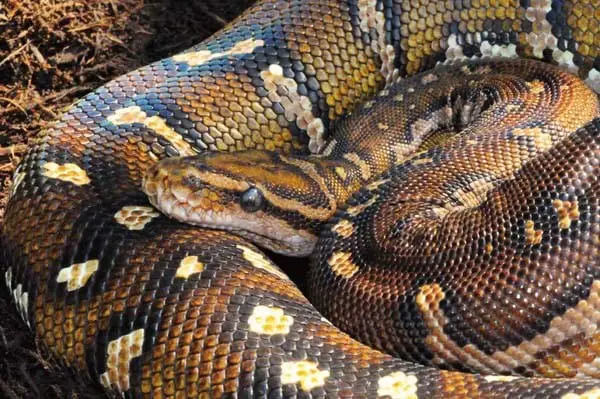
The Angola Python is a nonvenomous species of snake that can usually be found in Southern Africa. They are distinguishable for their reddish-brown, brown, or almost black scattered with some white and cream-colored bands and spots all over. On its underside, you will be able to see a yellowish belly. This type of python grows up to 6 feet or 183 cm in length, including its tail. This python is also famous for having head scales that are shaped like beads, and it has dorsal scales that are smooth to the touch and can be found arranged in 57 to 61 rows.
Unlike other snakes, touching an Angolan python feels bumpy while other snakes feel smooth. These scales are very common in reptiles, and this unique morphology is due to their arid habitats. It allows them to store the moisture that they encounter from condensation or rains.
Their eyes are found on the sides of their heads and are large but proportionate to the size of their heads. Because of this, the Angolan python almost looks like an insect.
Conservation Status
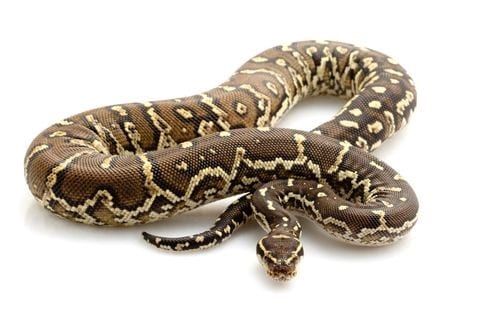
According to the IUCN Red List of Threatened Species published in 2010, Angolan pythons belong to animals of Least Concern, meaning their population is appropriately spread out across their usual territories.
Life Span
Angolan pythons usually live for 30 years, but it can be even longer if they are in great captive care.
Availability and Natural Habitat

Most Angolan Pythons are found in Africa, Northern Namibia, and Southern Angola. Its specific locality is pointed at Catumbella or Lobito Angola. Their preferred habitats vary from grasslands, areas with rocky outcrops, small caves, crevices, and overhangs.
For keeping these as pets, Angolan pythons are considered as mostly unavailable, whether for private collectors or zoos. This snake is available in limited ranges only, and their habitats are usually inaccessible, which is why they are hard to transport from the wild into captivity.
Behavior
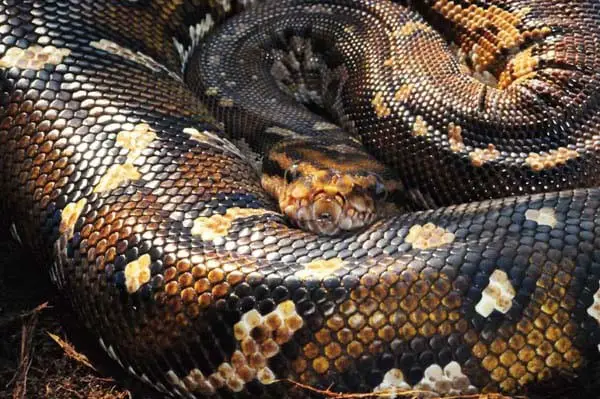
People might mistake Angolan pythons to be the same as the ball pythons. But one way to distinguish them from one another is their behaviors. Angolan Pythons, in general, tend to be more outgoing and interactive compared to the timid ball python.
Like other animals in the deserts, they usually forage around at night to escape the heat from the sun. Their large eyes allow them to see well even when in the dark.
Diet
Angolan Pythons prefer to eat frozen then thawed rats, or freshly killed ones if you can provide them. If you choose to feed your pet snake live prey, make sure that you do not leave them unattended and check that they are consumed properly by the python right away without any form of injury.
Eating Habits
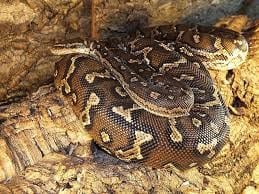
Before you feed your Angolan python, it would be best to stop handling them a few hours before.
While the snakes are still hatchlings until they are two years old, the best feeding time would be one appropriately sized rodent at least once a week. To find the appropriate size, measure the girth of your snake at its biggest area, and only choose prey that is about the same size. Though some in the community suggest that Angolan pythons can take rodents that are about 1.5 times as big as their girth, experts have observed that these snakes prefer smaller prey more.
For adult Angola pythons, you can adjust the feeding schedule to 1 rodent about every 2 weeks. But, make sure that the size of prey that you will feed your pet will be the appropriate one. If what you can provide is a slightly smaller meal, go for feeding once a week.
In terms of eating behavior, snakes usually do not like to eat when they are nearing their shedding periods. When its winter, young Angolan pythons would still choose to eat, but adult ones might want to skip on eating at this time. That behavior is fine, but it might to you good to still monitor your snake’s overall condition is good to make sure that the Angolan python has no underlying health condition to worry about.
Development and Reproduction
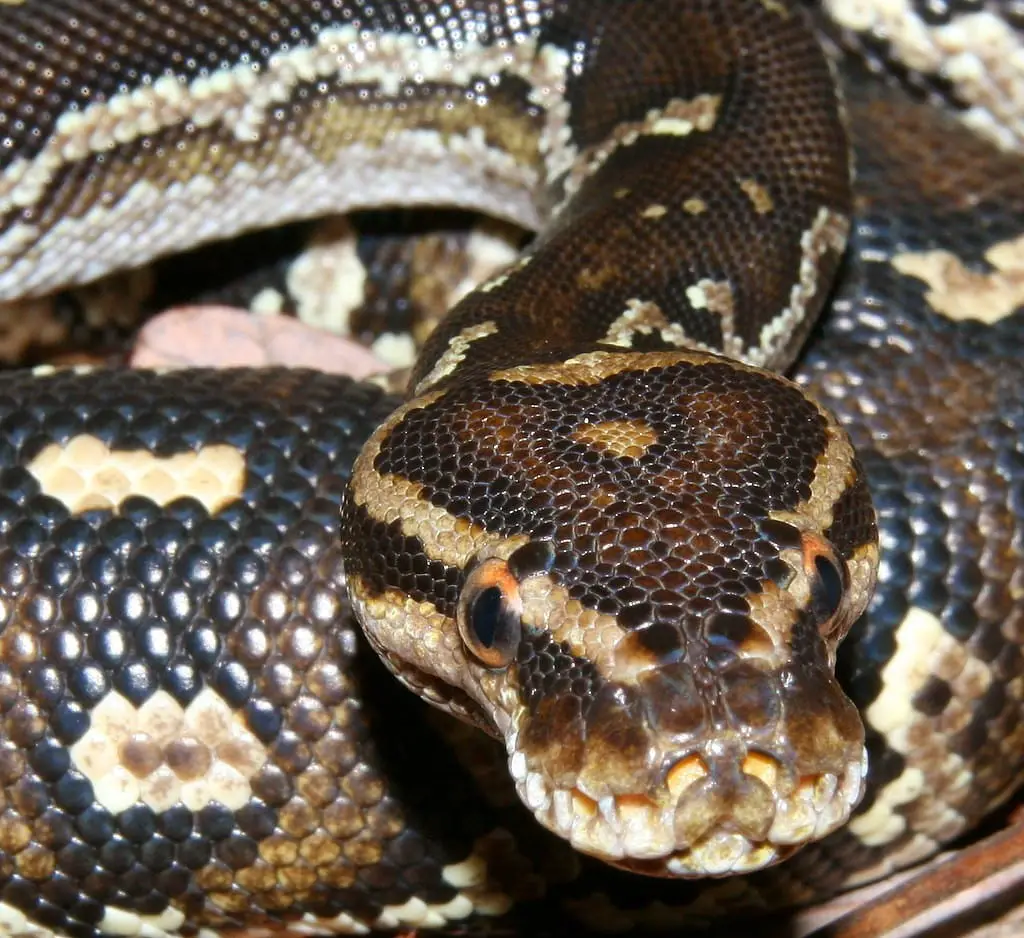
To breed Angolan Pythons, the females should reach about 1800 grams, and males should weigh about 1500 grams, ideally. The snakes must be exposed to lower temperatures at night and drop them for about 10 degrees for two weeks or more to stimulate or set the mood for breeding. During this cooling period, temperatures must be 78 to 80 degrees Fahrenheit during the daytime.
October is the perfect time to begin mating because the ovulation of the female Angolan pythons is at its peak during this month. The copulation between these snakes is often seen happening at night with long durations that tend to last until the early hours of the next morning. If the female snake is with a child, they are seen to be heavily distended because of the large egg inside, as the egg-laying comes much sooner.
When the female Angolan python appears gravid, they start nesting, so the owner should place them in a slightly damp long-fiber sphagnum moss. A nestbox made from terracotta flowerpots flipped upside down can do great as space for the python to comfortably hide. Make sure that the flowerpot you will use will be the appropriate size. Terracotta pots are perfect to use because the clay allows moisture to be retained and increases humidity in the nesting area.
Mating Season
The mating season for Angolan Pythons normally occurs every October.
Common Health Problems
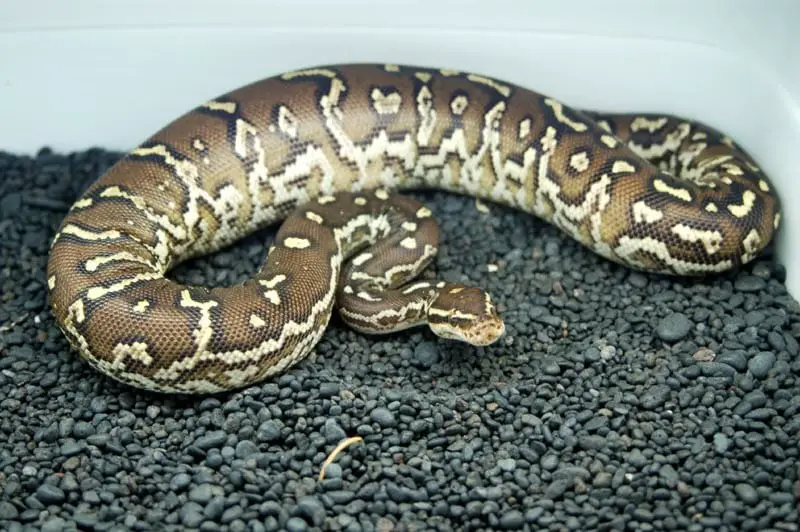
Like any other pet, Angolan pythons can get sick and feel too well. Therefore, owners must be aware of some health problems so that you can help avoid them.
1) Respiratory illnesses
This means that the lungs, throat, and nose of the snake are clogged by saliva, bacteria, and mucus. Signs are usually shown by dripping mucus, gurgling sounds, wheezing sounds, and breathing with their mouth open. To reverse this disease, make sure that the humidity in the enclosures is at the proper levels.
2) Stomatitis or mouth rot
Mouth rot is basically an infected wound that also smells unpleasant. The wound might be oozing pus, and the inside of the mouth is pink and red. This is a type of illness that you should have treated quickly to avoid the infection to lead into the bloodstream. You should take your Angolan python to the vet right away when this happens.
3) Shedding problems
Shedding is a normal part of the life cycle of a snake, but sometimes, they encounter problems that hinder them from shedding all of their skin at once. To help to beat this, increase the humidity of the enclosure or soak your snake into the bath.
Handling
If you want to handle an Angolan python, just remember always to support its body. If your pet snake feels that you are not a predator to fear, it is a type of snake that often enjoys being handled. But, you should avoid touching your Angolan python’s head, so that it will not feel threatened by you. If you are someone that they are not familiar with yet, the python will immediately jerk back when you attempt to touch its head. Start with gentle handling and work your way from there.
Caging
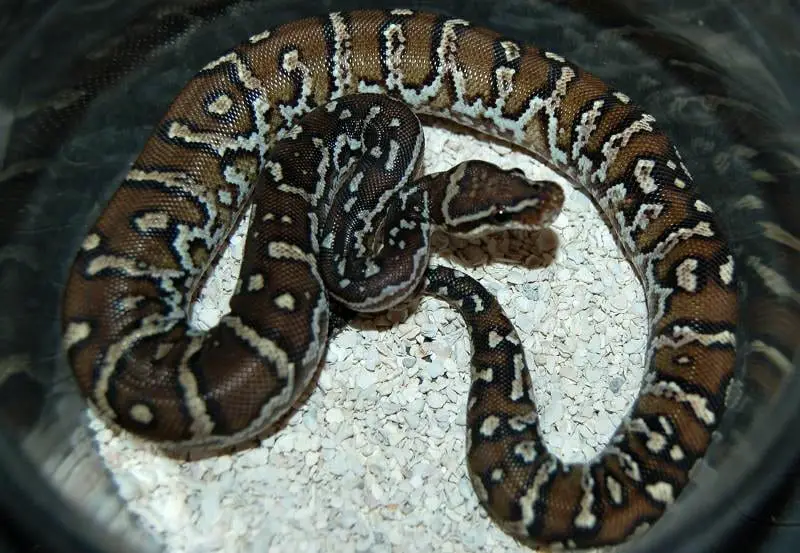
In the wild, these snakes are usually seen living in rocky climates and hiding under ledges or rocks. Their babies can be started in 10-gallon enclosures. When they reach about a year old, they can be observed to increase in size. You can use both commercially available plastic reptile cages or the usual glass aquariums. Both are used by growers, so choose whichever you prefer more.
Those who are a year old can stay at a living space that is around 30 inches by 12 inches long. For adults, they will feel comfortable living in a tank that is at least 36 inches by 18 inches.
Substrate
If you prefer to use glass aquariums, make sure that you can provide a reptile hide, which comes with some added damp moss to boost the humidity in the enclosure. You should also add some bedding for your Angolan python. The best substrates can be jungle mix, aspen flooring, forest flooring, repti barks, or eco earth.
To maintain cleanliness in the enclosure, you should do some spot checks and clean whenever your snake defecates. Additionally, replace the substrates at least once a month. You should also disinfect the entire living space before adding the new substrates.
Lighting
Depending on the temperature of their surroundings, the enclosure of the Angolan python might not need extra heat lights to be healthy. Some enclosures will be heated enough by basic household light bulbs, but for others, you need to install some basking lights.
For incandescent bulbs, the wattages required all depend on how you can provide your enclosure with the proper temperatures. The smaller the tank is, the lower the wattage required.
Temperature
Because Angolan Pythons originate from Africa, they are used to warmer temperatures. Like other reptiles, they are dependent on thermoregulation so that they can control the temperatures of their bodies. In simpler terms, this means that you need to provide your Angolan Python a cooling area and a warm corner in their living enclosures. In this way, your snake will have the freedom to move back and forth between two polarizing temperatures, depending on which one they prefer more.
For the hot side, you should maintain at least 87 to 90 degrees Fahrenheit. This will be enjoyed by your pet snake during its basking time. For the cooler side, around 75 to 80 degrees, Fahrenheit will be ideal for your python. You can also allow the cooling up to 72 temperature during the nights. For a better experience, place a hiding area or a hide box on both the hot and cold sections of the snake’s tank, so your snake can burrow inside and relax there.
If you want to go the extra mile, you can also use a heating pad working 24 hours a day to give your Angolan Python a little extra heat during the colder evenings. You should also install an excellent temperature gauge to control better and manage the situation of your snake.
Humidity
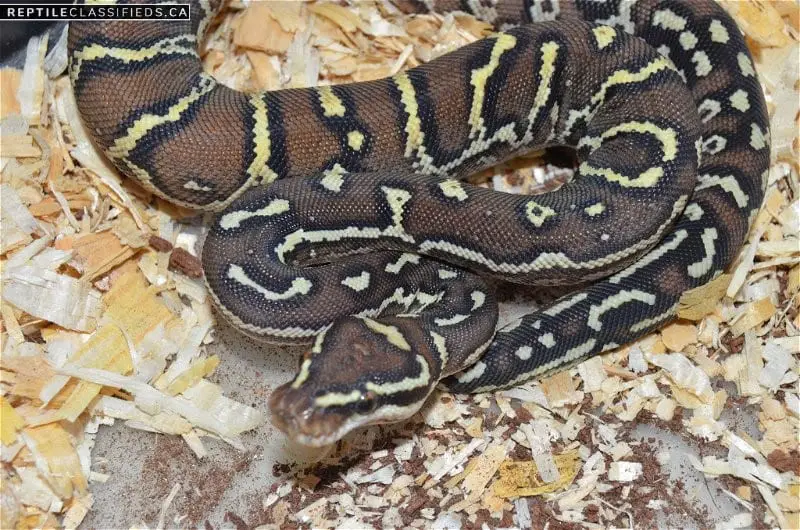
To provide humidity in the growing area, you should keep a non-porous water container that is also accessible by your snake. For safety purposes, make sure that this water bowl’s contents are regularly replaced and are always clean. To avoid the build-up of slime and bacteria, scrub the water container as much as you can. The best humidity levels will be about 50 percent. This level is enough to aid your snake in proper shedding of their skins. Additionally, you can use hand misters or automated misters as an additional initiative for humidity needs.
Fun Facts about Angolan Python

- Angolan pythons are also called as Anchieta’s dwarf python.
- Angolan pythons usually measure around 183 centimeters or 6 feet.
- Angolan pythons are nonvenomous snake species that are found in South Africa.
- Touching Angolan snakes feel bumpy because of its beady scales.
- Angolan pythons can survive extreme temperatures as low as 32 degrees Fahrenheit and 122 degrees Fahrenheit.
- Angolan pythons usually eat lizards, ground birds, and gerbils.
- Angolan pythons have five heat-sensitive pits all over their bodies.
- Angolan pythons usually eat frozen, then thawed rats and freshly killed mice.
- A terrarium or custom cage for Angolan python should be no smaller than 2 feet tall, 2 feet wide, and 2 feet long.
- Angolan pythons are not hard to maintain and rarely need misting.
Where Can You Get a Pet Angolan Python?
If you want to have your own Angolan python, you can purchase captive-bred ones from professional breeders and exotic pet stores.
How to Care for a Pet Angolan Python?
Caring for Angolan Pythons are fairly predictable and straightforward. Though they survive well in clean and stark enclosures, these snakes prefer setups filled with arid plantings and rocky shelves. If you decide to construct these elaborate setups with rocky shelves, be very careful to anchor the rocks well.
Frequently Asked Questions
Are Angolan Pythons dangerous?
By nature, Angolan pythons are unpredictable. They are not venomous, but they can still inflict injuries to humans if they are triggered and threatened.
Do Angolan Pythons bite?
Pythons are not venomous biters, and they only kill by constricting. They can bite occasionally, but this does not come with venom.
Are Angolan pythons water snakes?
No, Angolan pythons live in dry, arid areas.
How long are Angolan pythons?
Angolan pythons are usually 5 to 6 feet long, but they can grow even longer in captivity.
Where do Angolan pythons usually live?
Angolan pythons are usually seen in rocky areas and caves near-desert lands.
Why are Angolan pythons called Anchieta’s dwarf python?
This is because these snakes are named after Jose de Anchieta, a famous Portuguese explorer.



